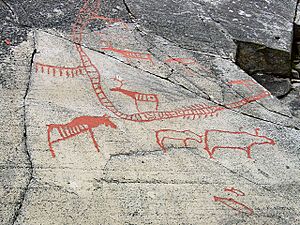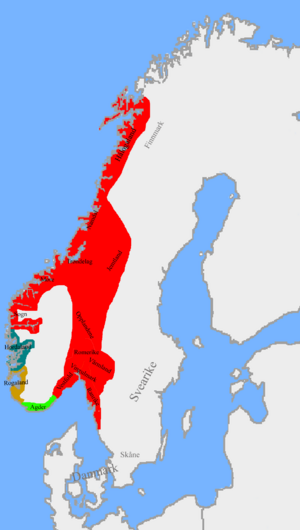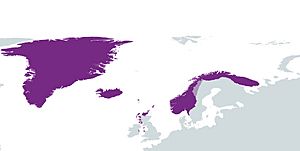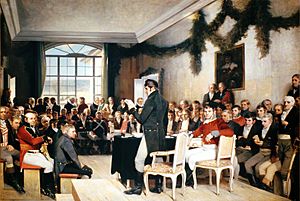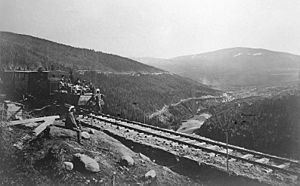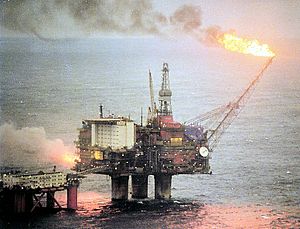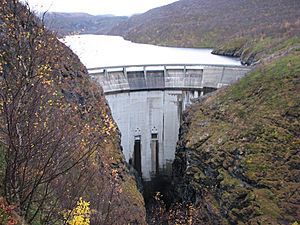History of Norway facts for kids

The history of Norway has been greatly shaped by its mountains, fjords, and climate. Around 10,000 BC, after huge ice sheets melted, the first people moved north into what is now Norway. They followed the coast, which was kept warm by the Gulf Stream. These early people were hunters and gatherers, eating seafood and animals like reindeer. Between 5,000 BC and 4,000 BC, the first farms appeared near the Oslofjord. Farming slowly spread across southern Norway by 1500 BC to 500 BC. People in the north continued to hunt and fish.
The Neolithic period began around 4000 BC. Later, during the Migration Period, powerful leaders called chieftains took charge, and people built forts on hills. From the 700s, Norwegians began exploring across the seas, reaching the British Isles, then Iceland and Greenland. This time, known as the Viking Age, also saw Norway become one united country. Christianity arrived in the 1000s, and Nidaros (now Trondheim) became an important church center. The population grew fast until 1349, when the Black Death (a terrible plague) cut it in half. Bergen became a major trading port, controlled by the Hanseatic League. In 1397, Norway joined the Kalmar Union with Denmark and Sweden.
After Sweden left the union in 1523, Norway became the less powerful partner in Denmark–Norway. The Reformation (a big change in the church) happened in 1537, and the king gained total power in 1661. In 1814, after losing the Napoleonic Wars with Denmark, Norway was given to the king of Sweden by the Treaty of Kiel. Norway declared itself independent and wrote its own constitution. However, other countries did not recognize Norway's independence. After a short war with Sweden, Norway agreed to a personal union with Sweden. This meant Norway kept its own constitution, parliament (Storting), and separate government, but shared a king and foreign policy with Sweden. The union officially began on November 4, 1814.
Factories and industries started growing in the 1840s. From the 1860s, many Norwegians moved to North America. In 1884, the king appointed Johan Sverdrup as prime minister, which meant that the government had to have the support of the parliament. The union with Sweden ended peacefully in 1905. From the 1880s to the 1920s, Norwegian explorers like Fridtjof Nansen and Roald Amundsen led important trips to the North and South Poles.
Shipping and hydroelectricity (power from water) became very important for Norway's economy. The country faced economic ups and downs, and the labor movement (workers' rights groups) grew stronger. Germany occupied Norway during World War II from 1940 to 1945. After the war, Norway joined NATO and rebuilt its economy with government planning. Oil was found in 1969, and by 1995, Norway was the world's second-largest oil exporter. This brought a huge increase in wealth. From the 1980s, Norway began to make its economy more open, but it also had a banking crisis in 1989–1990.
By the 2000s, Norway became one of the richest countries in the world. Oil and gas production made up 20 percent of its economy. By saving and reinvesting its oil money, Norway had the world's largest government fund in 2017.
Contents
Early History
Norway's coastline appeared from under glaciers around 12,000 BCE. The first people arrived then, finding rich opportunities for hunting seals, fishing, and hunting animals. These early people moved around a lot. By 9300 BCE, they had settled as far north as Magerøya. As more ice melted from 8000 BCE, people settled along the entire coast. The Stone Age in Norway is known through the Komsa culture in the north and the Fosna culture further south. The Nøstvet culture followed the Fosna culture around 7000 BCE, when warmer weather brought more forests and new animals to hunt. The oldest human skeleton found in Norway, discovered in 1994, is from 6,600 BCE. Around 4000 BCE, people in the north started using tools made of slate, pottery, skis, sleds, and large boats made of animal skins.
The first farming began around 4000 BCE near the Oslofjord, using methods from southern Scandinavia. A big change happened between 2900 and 2500 BCE, when oats, barley, pigs, cattle, sheep, and goats became common. Farming spread as far north as Alta. During this time, the Corded Ware culture arrived, bringing new tools, weapons, and an Indo-European language that later developed into the Norwegian language.
Bronze Age (1800–500 BC)
The Bronze Age started around 1800 BCE. New ideas included using ploughs to farm fields and building permanent farms with houses and yards. This was especially true in fertile areas like the Oslofjord, Trondheimsfjord, Mjøsa, and Jæren. Some farms produced so much that farmers could trade furs and skins for fancy items, especially with Jutland. Around 1000 BCE, people speaking Uralic languages arrived in the north and mixed with the local people, becoming the Sami people.
Around 500 BCE, the climate became colder. Forests changed from elm and oak to birch, pine, and spruce. The colder weather also meant farmers built stronger homes for shelter. People learned about ironworking from the Celts, which led to better weapons and tools.
Iron Age (500 BC–800 AD)
Iron Age tools allowed people to clear more land and farm more widely. As harvests grew, the population increased. A new social structure developed: when sons married, they stayed in the same house, forming a large family group called a clan. Clans protected each other. If there were problems, they would be settled at a thing, a special meeting place where all free men from the area gathered to solve arguments and decide punishments.
In the last century BCE, culture developed a lot. The Norse people created their own alphabet, called runes. They also traded with Romans, mostly furs and skins for luxury goods. Some Scandinavians even worked as Roman soldiers. The most powerful farmers became chieftains. They acted as priests and received gifts from farmers, which they used to pay soldiers. This helped them rule areas with many clans and tribes.
The power of chieftains grew during the Migration Period (400 to 550 AD). Other Germanic tribes moved north, and local farmers wanted protection. This led to the building of simple forts. A plague hit southern Norway in the 500s, causing many farms to become empty. Most were repopulated in the 600s, which also saw the growth of fishing villages and a boom in trade of iron and soapstone across the North Sea. Some chieftains gained control of most trade and became very powerful in the 700s.
Archaeological Discoveries
In February 2020, scientists found a 1,500-year-old Viking arrowhead in a glacier in southern Norway. It was from the Germanic Iron Age and was uncovered because of climate change in the Jotunheimen Mountains. The iron arrowhead was 17 cm long and weighed only 28 grams, and its cracked wooden shaft and a feather were still attached.
Viking Age
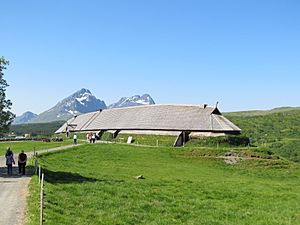
The Viking Age was a time when Scandinavians expanded through trade, raids, and settling new lands. One of the first famous raids was on Lindisfarne in 793, which many see as the start of the Viking Age. This expansion was possible because of the longship, a ship good for sea travel, and advanced navigation skills.
Vikings were well-equipped, often wearing chain mail armor, and were well-trained fighters. Besides gold and silver, an important goal of raids was to capture and trade thralls (slaves). These slaves were brought to Norwegian farms to work. When the men were away fighting or traveling, the women supervised the homestead.
Because there wasn't enough good farming land in Western Norway, Norwegians traveled to and settled in places with few people, like Shetland, Orkney, the Faroe Islands, and the Hebrides. The Hebrides even became the Kingdom of the Isles. Norwegian Vikings settled on the east coast of Ireland around 800 AD and founded the island's first cities, including Dublin. Their arrival caused the small Gaelic kings to unite, and by 900 AD, they had driven out the Norwegians.
In the mid-800s, the most powerful chieftains of Norway's small kingdoms were fighting for control. Harald Fairhair began to unify Norway by joining forces with the Earls of Lade. He managed to unite the country after the important Battle of Hafrsfjord (around 870–900 AD). He set up a basic government, placing his officials in charge of the lands of defeated or exiled chieftains.
Iceland, which had no people living there, was discovered by Norwegians in the late 800s. By 930 AD, the island was divided among 400 Norse chieftains.
Håkon the Good, Harald Fairhair's son, who grew up in England, became king in 930 AD. He set up two large things (assemblies) where the king met with free men to make decisions: Gulating for Western Norway and Frostating for Trøndelag. He also created the leidang, a system to call up an army or navy. Haakon tried to introduce Christianity to Norway but didn't succeed. After he died in 960 AD, wars broke out between the Fairhair dynasty and the Earls of Lade, who were allied with Danish kings.
Led by Erik the Red, a Norwegian-born man, a group of Icelanders settled on Greenland in the 980s. Erik's son, Leif Ericson, found Newfoundland around 1000 AD, calling it Vinland. Unlike Greenland, no permanent settlement was made there.
Archaeological Discoveries
Several Viking ships have been found in burial mounds and are now in museums, including the Oseberg and Gokstad ships. In October 2018, Norwegian archaeologists announced the discovery of a buried 20-meter-long Gjellestad Viking ship in Halden. They used ground-penetrating radar to find an old, well-preserved Viking cemetery over 1000 years old. The radar also showed at least seven other unknown burial mounds and the remains of five longhouses.
Middle Ages
The effort to bring Christianity to Norway and end the old Norse religion was first tried by Håkon the Good, and later by Olav Tryggvason. But Olav was killed in the Battle of Svolder in 1000 AD. Olav Haraldsson, starting in 1015, made the things pass church laws, destroyed old pagan temples, built churches, and created a system of priests. Many chieftains worried that Christianity would take away their power as Goðar (religious leaders) in the old religion. They had Olaf sent away from Norway in 1028. When he tried to return in 1030, he was killed by locals in the Battle of Stiklestad. The church later made Olaf a saint, and Nidaros (today Trondheim) became the main Christian center in Norway. Within a few years, Danish rule became unpopular, and Norway united again under a Norwegian king, Magnus Olavson the Good, in 1035.
From the 1040s to 1130, Norway was peaceful. In 1130, a civil war began over who should be king. This allowed all the king's sons to rule together by dividing Norway into parts for each to govern. Sometimes there were peaceful times, but then a younger son would team up with a chieftain and start a new fight. The Archdiocese of Nidaros (a church region) was created in 1152 to try and control who became king. The church often took sides in these conflicts, and its influence on the king also became a problem in the civil wars. The wars ended in 1217 when Håkon Håkonsson became king and set clear rules for who would inherit the throne. He also brought Greenland and Iceland under Norwegian rule.
The population grew from 150,000 in 1000 AD to 400,000 in 1300 AD. This meant more land was cleared for farming, and farms were divided into smaller parts. In the Viking Age, all farmers owned their land, but by 1300, seventy percent of the land was owned by the king, the church, or rich families. This happened slowly as farmers borrowed money in hard times and couldn't pay it back. However, tenant farmers in Norway were always free men and had more freedom than serfs in other parts of Europe. In the 1200s, about twenty percent of a farmer's harvest went to the king, church, and landowners.
Decline and the Kalmar Union
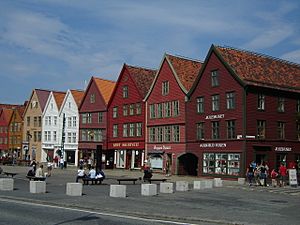
The 1200s are called Norway's Golden Age. It was a time of peace and increased trade, especially with the British islands. However, Germany became more important for trade towards the end of the century. Throughout the High Middle Ages, the king made Norway a strong country with a central government and local officials.
In 1349, the Black Death arrived in Norway and killed almost two-thirds of the population within a year. Later plagues cut the population in half again by 1400. Many communities completely disappeared. This meant there was a lot of empty land, allowing farmers to switch to raising more animals. Fewer people meant less taxes for the king, which weakened his power. Many rich families lost their extra income and some became simple farmers. High church taxes made the church more powerful, and the archbishop became a member of the king's council.
The Hanseatic League (a group of German merchants) took control of Norwegian trade in the 1300s. They set up trading posts in most Norwegian port cities, like Oslo and Bergen, which had the largest German community. In 1380, Olaf Haakonsson became king of both Norway and Denmark, creating a union between the two countries. In 1397, under Margaret I, the Kalmar Union was formed between the three Scandinavian countries (Denmark, Norway, and Sweden). Margaret fought against the Hanseatic League, which led to trade blockades and higher taxes on Norwegians, causing a rebellion. However, Norway and its council were too weak to leave the union.
Margaret's policies focused on centralizing power, which naturally favored Denmark because it had more people than Norway and Sweden combined. Margaret also gave special trading rights to the Hanseatic merchants from Lübeck in Bergen in exchange for them recognizing her rule. This hurt the Norwegian economy. The Hanseatic merchants formed a powerful group in Bergen for many generations. Even worse were pirates, called the "Victual Brothers," who attacked the port three times, causing great damage (the last time in 1427).
Norway became less important under the Oldenburg dynasty (which started in 1450). There was a revolt led by Knut Alvsson in 1502. Norwegians liked King Christian II, who lived in the country for several years. Norway did not play a part in the events that led to Sweden's independence from Denmark in the 1520s.
Union with Denmark
Sweden managed to leave the Kalmar Union in 1523. This created Denmark–Norway, ruled by a king in Copenhagen. King Frederick I supported Martin Luther's Reformation, but it was not popular in Norway. The Church was the only strong national institution left in Norway, and the country was too poor for its clergy to be very corrupt. At first, Frederick agreed not to bring Protestantism to Norway, but in 1529 he changed his mind. Norwegian resistance was led by Olav Engelbrektsson, the Archbishop of Trondheim, who invited the old king Christian II back from exile. Christian returned, but his army was defeated, and he spent the rest of his life in prison.
Norway as a Junior Partner
When Frederick died, a three-way war broke out over who would be king. Olaf Engelbrektsson again tried to lead a Catholic resistance movement in Norway. Christian III won the war. In 1537, Christian made Norway a puppet state, meaning it was no longer an independent kingdom. He also ended the Norwegian Council of State. The Reformation was also forced upon Norway in 1537, which made the king even more powerful. All church treasures were sent to Copenhagen, and the forty percent of land owned by the church came under the king's control. Danish became the written language, though Norwegian kept its own dialects. A professional government was now needed. Power shifted from local nobles to the king's officials. Judges were appointed, and local sheriffs became royal employees. In 1572, a viceroy was appointed for Norway, based at Akershus Fortress in Oslo. In 1628, the Norwegian Army was created, with professional military officers.
The Norwegian economy improved when water-powered sawmills were introduced in the early 1500s. Norway had huge amounts of timber but couldn't use much of it in the Middle Ages because only hand tools were available. The new sawmills that appeared in the fjords changed this. In 1544, a deal was made with the Netherlands, and the Dutch controlled the export of Norwegian timber for the next 150 years. Amsterdam was built on piles made from Norwegian wood. Trees were cut down in winter when farm work was slow, and it was easy to move the felled trees across the snow to the rivers. In spring, the logs floated down the rivers to the sawmills by the sea. By the mid-1500s, the power of the Hanseatic League in Bergen was broken. German craftsmen remained, but they had to accept Danish-Norwegian rule.
The 1600s saw many wars between Denmark–Norway and Sweden. The Kalmar War (1611–1613) involved 8,000 Norwegian farmers being forced into the army. Even though they lacked training, Denmark–Norway won, and Sweden gave up its claims to land between Tysfjord and Varangerfjord. When Denmark joined the Thirty Years' War (1618–48), a new system was created where the country was divided into 6,000 areas, each required to support one soldier. Denmark–Norway lost the war and had to give Jämtland and Härjedalen to Sweden. The Second Northern War (1657–1660) resulted in Bohuslän being given to Sweden.
Absolute Monarchy (1661-1814)
King Frederick III made himself an absolute and hereditary king of Denmark and Norway in 1661, taking away the power of the nobles. A new government system was introduced. Different government departments were set up in Copenhagen. Norway was divided into counties, each led by a governor, and further divided into smaller areas. About 1,600 government officials were appointed across the country. Ulrik Fredrik Gyldenløve was the most famous viceroy (king's representative) of Norway from 1664 to 1699.
Norway's population grew from 150,000 in 1500 to 900,000 in 1800. By 1500, most empty farms were taken over again. During the time of absolute monarchy, the number of farmers who owned their own land increased from twenty to fifty percent. This was largely because the king sold crown land to pay for lost wars. Small tenant farms became common, especially in Eastern Norway and Trøndelag. The smallholder depended on the farmer who owned the land. In 1800, there were 48,000 smallholders. Compared to Denmark, taxes were very low in Norway, usually four to ten percent of the harvest. Confirmation (a church ceremony) was introduced in 1736; since it required people to read, basic education began.
Throughout this period, trade was based on mercantilism. This meant rules about imports, tariffs (taxes on goods), monopolies, and special rights given to merchants. The lumber industry became important in the 1600s, especially for exports to England. To prevent too many trees from being cut down, a royal order closed many sawmills in 1688. This mostly affected farmers with small mills. By the mid-1700s, only a few merchants controlled the entire lumber industry. Mining increased in the 1600s, with the largest mines being silver in Kongsberg and copper in Røros. Fishing continued to be an important source of income for coastal farmers. From the 1700s, dried cod began to be salted, which meant fishermen had to buy salt from merchants. Norway's first important period of shipping was between 1690 and 1710, but this advantage was lost when Denmark–Norway joined the Great Northern War in 1709. However, Norwegian shipping grew strong again towards the end of the century. Many Norwegians worked as sailors on foreign ships, especially Dutch ones. Norway benefited from the many European wars in the 1700s. As a neutral country, it could expand its share of the shipping market. It also supplied timber to foreign navies.
Throughout this time, Bergen was the largest town in Norway. Its population of 14,000 in the mid-1700s was twice the size of Christiania (later Oslo) and Trondheim combined. In 1660, there were eight towns with special trading rights. By 1800, this had grown to twenty-three. During this period, up to two-thirds of Norway's national income was sent to Copenhagen. In the last decades of the century, Hans Nielsen Hauge started a religious movement that demanded the right to preach freely. The University of Oslo was founded in 1811.
Union with Sweden
Denmark–Norway joined the Napoleonic Wars on France's side in 1807. This badly hurt the Norwegian economy because the British navy blocked ships, stopping exports and food imports. Sweden invaded Norway the next year, but a ceasefire was signed in 1809 after several Norwegian victories. After pressure from Norwegian merchants, special trade permits allowed corn from Denmark to Eastern Norway in exchange for Norwegian timber export to Great Britain. After the Battle of Leipzig in 1813, the Treaty of Kiel was signed on January 14, 1814, giving Norway to the king of Sweden.
Christian Frederik, who was supposed to inherit the Danish and Norwegian crowns, had been the king's representative in Norway since 1813. He led the Norwegian resistance against the Kiel Treaty and planned to claim the throne himself. He traveled to Trondheim to get support and then gathered twenty-one important citizens at Eidsvoll on February 16, 1814, to discuss his plans. They rejected a new absolute monarchy and advised him to call a meeting to write a liberal constitution and decide the form of government. Representatives from all over the country were elected to meet at Eidsvoll. The 112 members of the Constituent Assembly met and, after six weeks of talks, finished the Constitution of Norway on May 17, 1814. Power would be shared between the king (Christian Frederik was appointed) and the Parliament of Norway. The Swedish army, led by Crown Prince Carl Johan of Sweden, invaded Norway in late July. At the ceasefire, the Convention of Moss on August 14, Norway agreed to enter a personal union with Sweden on equal terms. Sweden accepted the Norwegian Constitution and separate institutions in both states. King Christian Frederik agreed to call a special parliament to change the Constitution and then step down. The parliament met in Christiania on October 7, and the necessary changes were made on November 4, 1814. On the same day, King Charles XIII of Sweden was elected king of Norway, officially starting the Union.
Growth and Change
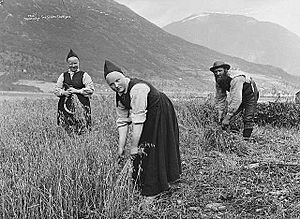
The Napoleonic Wars caused an economic crisis in Norway, as almost all merchants went bankrupt during the blockades. Recovery was hard because of export taxes, and the country had high inflation. The Norwegian speciedaler was created as currency by the Bank of Norway when it was founded in 1816. It was funded by a silver tax that lasted until 1842. Under threat of a takeover by Carl Johan, Norway reluctantly paid the debt mentioned in the Treaty of Kiel, even though Norway had never officially agreed to it. Constitution Day on May 17 became an important political gathering every year. In 1829, the Swedish governor-general Baltzar von Platen resigned after using force against people celebrating in the Battle of the Square. The first half of the century was controlled by about 2,000 government officials. There were few wealthy citizens and no nobles after a decision in 1821 to end nobility. From the 1832 election, farmers became more active in electing themselves, leading to a majority of farmers in Parliament. This resulted in lower taxes for rural areas and higher import taxes, shifting the tax burden to the cities. They also passed the Local Committees Act, which created elected local councils from 1838. Norwegian culture from the 1840s to the 1870s was shaped by romantic nationalism, which highlighted Norway's unique identity.
The textile industry started in the 1840s, followed by workshops to build new machines, as a British embargo prevented importing textile machinery. An economic crisis hit the country from 1848. This led Marcus Thrane to create the first trade unions, demanding equal rights for all social classes. Parliament passed laws in the 1840s and 1850s to remove special economic privileges and make trade easier. Population growth forced people to clear new land, though some growth happened in cities. Christiania's population reached 40,000 in 1855. By 1865, the population was 1.7 million. This large increase was mainly due to better food from herring and potatoes, a sharp drop in infant deaths, and improved hygiene. People started moving to North America in 1825, with large numbers leaving from the 1860s. By 1930, 800,000 people had moved, mostly settling in the Midwestern United States.

The decrease in population led to a shortage of workers in agriculture. This resulted in more use of machinery and capital. The government helped this process by creating the Mortgage Bank in 1851 and the State Agricultural College eight years later. The 1800s saw a big increase in road building, and steamship services began along the coast. The first railway, the Trunk Line between Christiania and Eidsvoll, opened in 1854. A year later, the first telegraph line opened. Export industries started with steam-powered sawmills in the 1860s, followed by canned herring, wood pulp, and cellulose. From 1850 to 1880, the Norwegian shipping industry boomed, helped by Britain ending its Navigation Acts. By 1880, there were 60,000 Norwegian sailors, and the country had the world's third-largest merchant marine (commercial fleet). The Røros Line, the first railway connecting the capital to Trondheim, was completed in 1877. Norway joined the Scandinavian Monetary Union in 1875 and introduced the Norwegian krone with a gold standard. The metric system was also introduced.
The End of the Union
Parliamentary sessions became annual from 1869. In 1872, a constitutional change required ministers to attend Parliament to explain their policies. The king, even though he had no constitutional right to, vetoed this change three times. The 1882 election saw the first two political parties, the Liberals and Conservatives. The majority succeeded in impeaching the government. In 1884, King Oscar II appointed the Liberal leader Johan Sverdrup as prime minister. This established parliamentarism, meaning the government must have the support of the parliament, making Norway the first European country to do so. The Liberal Party introduced many legal reforms, such as giving voting rights to about half of all men. They also settled the Norwegian language conflict by creating two official written standards, Riksmål and Landsmål. They introduced juries, seven years of compulsory education, and, as the first European country, universal suffrage (voting rights for all men) in 1889.
The 1880s and 1890s saw the rise of the labor movement, and trade unions became common. The Norwegian Confederation of Trade Unions was founded in 1899, and the Norwegian Employers' Confederation the next year. The Labor Party had its first members elected to parliament in 1903. Women's rights became more important in the 1880s, and women were gradually allowed to attend higher education. Norwegian support for the union with Sweden decreased towards the end of the 1890s, especially after Sweden ended a free trade agreement in 1897 and Norway lacked its own foreign minister. Talks about independence began, but they were difficult because governments kept changing and Sweden threatened war.
Independence
With the four-party Michelsen's Cabinet appointed in 1905, Parliament voted to create a Norwegian consular service (diplomatic offices abroad). The king rejected this. On June 7, Parliament unanimously approved the dissolution of the union. In the following referendum, only 184 people voted to keep the union. The government offered the Norwegian crown to Denmark's Prince Carl. After a public vote, he became Haakon VII. In the next ten years, Parliament passed many social reforms, such as sick pay, factory inspections, a ten-hour workday, and worker protection laws. Waterfalls for hydroelectricity became an important resource. The government passed laws to prevent foreigners from controlling waterfalls, mines, and forests. Large industrial companies like Elkem, Norsk Hydro, and Sydvaranger were founded. The Bergen Line railway was completed in 1909. The Norwegian Institute of Technology was established the next year, and women's suffrage (the right for women to vote) was introduced in 1913, making Norway the second country in the world to do so. From the 1880s to the 1920s, Norwegians carried out many polar expeditions. The most important explorers were Fridtjof Nansen, Roald Amundsen, and Otto Sverdrup. Amundsen's expedition in 1911 was the first to reach the South Pole.

Norway adopted a policy of neutrality from 1905. During World War I, the Norwegian merchant fleet was largely used to support the British. This led to Norway being called "The Neutral Ally." Half of the Norwegian fleet was sunk, and 2,000 sailors were killed by German submarines. Some merchants made huge profits during the war, which increased the gap between social classes. The period between the two world wars was marked by economic problems, including strikes, lockouts, and government money policies that hindered investments. Fishermen were especially hard hit, while farmers kept market prices stable by organizing. Unemployment reached ten percent between 1931 and 1933. Although industrial production increased by eighty percent from 1915 to 1939, the number of jobs stayed the same. The Norwegian School of Economics was founded in 1936.
Norway had nine governments between 1918 and 1935, most of them minority governments lasting about eighteen months. The Agrarian Party was founded in 1920, though this period also saw more support for the Conservatives. The Labor Party split in 1921, with the left wing forming the Communist Party. Although strong in the 1920s, they became less important in the 1930s. A short-lived Labor Government ruled in 1928, but it didn't gain strong parliamentary support until the 1935 Nygaardsvold's Cabinet, which was based on an alliance with the Agrarian Party. During the 1920s and 1930s, Norway claimed three dependencies: Bouvetøya, Peter I Island, and Queen Maud Land. It also took control of Jan Mayen and secured sovereignty over Svalbard through the Svalbard Treaty. Norway's first civil airport, Stavanger, opened in 1937.
World War II

From the start of World War II in 1939, Norway tried to stay strictly neutral. Both Britain and Germany knew Norway was in a very important location. Both made plans to invade Norway, even if Norway didn't want them to. The Germans attacked first and invaded Norway on April 9, 1940. After fierce battles with Norwegian and British forces, Germany won and controlled the country until the end of the war. Germany's goal was to use Norway to control access to the North Sea and the Atlantic Ocean, and to base air and naval forces there to stop supply ships going from Britain to the Soviet Union.
Government in Exile
The Norwegian government, including the royal family, escaped to London. Political disagreements were put aside, and the government worked with the Allies. It kept control of Norway's diplomatic services around the world and managed the large Norwegian merchant fleet. It also organized and oversaw the resistance movement inside Norway. One lasting effect of the war was that Norway gave up its traditional policy of neutrality. Norway became a founding member of NATO in 1949. At the start of the war, Norway had the world's fourth-largest merchant fleet, including a fifth of the world's oil tankers. The Germans captured about 20% of the fleet, but the rest, about 1000 ships, were taken over by the government. Although half of these ships were sunk, the money they earned paid for the government's expenses.
Quisling's Government
Vidkun Quisling declared himself prime minister and appointed a government with members from his National Unity Party. He was quickly removed and replaced by Josef Terboven, but was brought back in 1942. The Norwegian Campaign continued in Northern Norway, and the government fled to London on June 7. The German occupation led to harsh treatment of the people, and 30,000 Norwegians were imprisoned. 55,000 people joined the National Unity Party, which became the only legal party. But the Nazi attempt to control society failed after the Supreme Court resigned, and both organized sports and bishops boycotted the new regime. A resistance movement was established and coordinated from London starting in 1943. Jokes against the Germans helped keep spirits up and build a wall against working with the enemy. People told jokes that showed contempt for the occupiers, made fun of Nazi ideas, highlighted their cruelty, and mocked their inflated self-image. For example, people would ask, "Do you know the difference between the Nazis and a bucket of manure? The bucket." In post office lines, they'd explain, "It's rumored that we're getting new stamps with Quisling's picture, but distribution has been delayed because no one knows which side to spit on." These jokes helped Norwegians understand the occupation and encouraged a sense of unity. When Germany surrendered on May 8, 1945, there were 360,000 German soldiers in Norway.
After the War
1945–1950
After World War II, a legal cleanup took place in Norway. 53,000 people were found guilty of treason, and 25 were executed. The years after the war saw more interest in Scandinavism (cooperation between Nordic countries). This led to Scandinavian Airlines System in 1946, the Nordic Council in 1952, and the Nordic Passport Union (allowing free travel between Nordic countries). Reconstruction after the war gave Norway the highest economic growth in Europe until 1950. This was partly achieved by limiting private spending to allow for more industrial investments. The Labor Party stayed in power and continued a policy of government planning. The University of Bergen was created in 1946. The 1950s saw a boom in building hydroelectric power plants. The state built the Norsk Jernverk steel mill and two aluminum factories. State banks, like the State Housing Bank and the State Educational Loan Fund, allowed the government to control private debt. Oslo hosted the 1952 Winter Olympics.
Norway kept its neutrality policy until 1947, focusing on its membership in the United Nations, where Trygve Lie became the first secretary-general. However, there wasn't much excitement for the UN at the time. Anti-communism grew after the Soviet Union suggested joint control over Svalbard and especially after the 1948 Czechoslovak coup d'état. After this, the Communist Party lost all its influence. Norway started talks to create a Scandinavian defense union, but instead chose to become a founding member of the North Atlantic Treaty Organization (NATO). However, Norway never allowed foreign troops or nuclear weapons to be permanently stationed on its soil to avoid upsetting the Soviet Union, with which Norway shared a land border from 1944. NATO helped finance large parts of Norway's military investments, which led to many airports being built in the 1950s and 1960s.
Marshall Plan
Norway joined the Marshall Plan in 1947, receiving US$400 million in American aid. The American leaders of the Marshall Plan were willing to work with the Norwegian Labor government's ERP Council, which surprised conservative Norwegian businesses. These businesses were represented by major organizations like Norges Industriforbund and Norsk Arbeidsgiverforening. While hesitant to work with the government, Norwegian business leaders also knew it would look bad to block the Marshall Plan. The American acceptance of government involvement in economic planning showed their New Deal reform ideas. The opportunities for agreement between conservative Norwegian business interests and the government during the Marshall Plan helped create a basis for Norwegian corporatism (cooperation between government, business, and labor) in the 1950s.
1950 to 1972
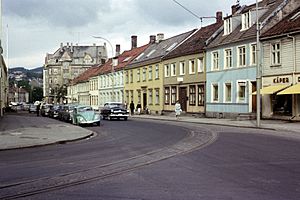
The sale of cars was allowed freely in October 1960. In the same year, the Norwegian Broadcasting Corporation started Norway's first television broadcasts. Norway worried about competition from Swedish industry and Danish agriculture. It chose not to join any free trade organizations until 1960, when it joined the European Free Trade Association. Throughout the post-war period, both fishing and agriculture became more mechanized. Farm subsidies rose to the third-highest in the world, and the number of small farms and fishermen dropped sharply. The Socialist People's Party was created in 1961 by former Labor politicians who disagreed with the Labor Party's policies on NATO, nuclear weapons, and Europe. After the Kings Bay Affair (a mining accident), the Conservative Lyng's Cabinet ruled for a month. The Conservative coalition Borten's Cabinet won the 1965 election, stayed in power for six years, and started a trend of alternating Labor and Conservative governments. The "Norwegianization" of Sami people stopped after the war, and Sami rights became a growing issue, with a council being established in 1964.
The Nordland Line railway to Bodø was completed in 1962, finishing the construction of new railway routes. The first part of the Oslo Metro opened in 1966. A social safety net was gradually introduced after the war, with child allowances starting in 1946 and the Social Care Act in 1964. The 1960s were good for heavy industry. Norway became Europe's largest exporter of aluminum and the world's largest exporter of ferroalloys. The University of Trondheim and the University of Tromsø both opened in 1968, one year before a network of regional colleges began to open. Influenced by American culture and similar movements abroad, young people and students started to challenge cultural norms. The 1960s saw more focus on environmental protection, especially through activism, due to more waterfalls being used for hydro stations, pollution, and the decline of herring stocks. Rondane National Park was created as Norway's first national park in 1962, and the Ministry of the Environment was the first in the world when it was established in 1972. A network of regional airports was built in Western and Northern Norway in the late 1960s and early 1970s. Membership in the European Economic Community was rejected in a 1972 referendum.
Oil Age
Searching for oil in the North Sea began in 1966. In 1969, Phillips Petroleum found oil in the Ekofisk field, which turned out to be one of the ten largest fields in the world. Oil operations were shared between foreign companies, the state-owned Statoil, the partly state-owned Norsk Hydro, and Saga Petroleum. Ekofisk had a major blowout (uncontrolled release of oil or gas) in 1977. 123 people died when the Alexander Kielland accommodation rig capsized in 1980. These incidents led to stronger safety rules for petroleum. The oil industry not only created jobs in oil production but also led to many supply and technology companies being established. Stavanger became the center of this industry. High petroleum taxes and profits from Statoil gave the government a lot of income from the oil industry.
Norway created its exclusive economic zone in the 1970s, gaining an area of 2 million square kilometers. A series of border disputes followed. Agreements were reached with Denmark and Iceland in the 1990s, but the border in the Barents Sea was not agreed upon until 2010. Between 1973 and 1981, the country was ruled by the Labor Party, which carried out many reforms, such as a new school system. Farmers received more subsidies, and from 1974, women were allowed to inherit farms. Loans guaranteed by future oil income allowed Norway to avoid a recession in the mid-1970s. But by 1977, high wages made Norwegian industry less competitive, and a soaring economy forced cuts in public and private spending. Fish farming became a new, profitable industry along the coast.
More people started moving to Norway in the late 1960s, mostly from Western Europe and the United States. From the 1970s, more skilled workers came for the oil industry. This period also saw more unskilled workers from developing countries, especially Pakistan. Oslo became the main city for immigrants, though rules from 1975 slowed this significantly. The Alta controversy began in the 1970s when Statkraft planned to build a dam on the Alta River. This case brought together environmental and Sami interest groups. Although the Alta Power Station was built, the issue changed the political mood and made large-scale hydroelectric projects harder to build. The Sami Parliament was established in 1989.
The Conservative Party won the 1981 elections and carried out major reforms to reduce government control: taxes were cut, local private radio stations were allowed, private companies set up cable television, rules on borrowing money were removed, and foreigners were allowed to buy stocks. An economic crisis hit in 1986 when foreigners started selling Norwegian currency, which forced an increase in taxes, and Prime Minister Kåre Willoch had to resign. The Progress Party, which is more right-wing than the Conservatives, became popular in the late 1980s. High wages in the oil industry made low-skill manufacturing industries less competitive. The Labor Party closed many state-owned industrial companies that were receiving large subsidies. The 1980s saw a threefold increase in people on disability, mostly among older workers, and the crime rate rose.
The underwater Vardø Tunnel opened in 1982. Since then, Norway has built many underwater tunnels to connect island communities to the mainland. From the 1980s, the largest cities introduced toll rings (fees to drive into the city) to pay for new road projects. A banking crisis hit Norway in the late 1980s, causing the largest banks, such as Den norske Bank, Christiania Bank, and Fokus Bank, to be taken over by the state. Norsk Data, a company that made minicomputers, became Norway's second-largest company by 1985, but went bankrupt by 1993. Unemployment reached record-high levels in the early 1990s.
By 1990, Norway was Europe's largest oil producer, and by 1995, it was the world's second-largest oil exporter. Membership in the European Union was rejected in a 1994 referendum. Instead, Norway joined the European Economic Area and later the Schengen Area (allowing free travel). Large public investments in the 1990s included a new National Hospital and Oslo Airport, Gardermoen. The airport was connected to the capital by Norway's first high-speed railway, the Gardermoen Line. Many large government companies, such as Statoil, Telenor, and Kongsberg, were privatized (sold to private owners). Lillehammer hosted the 1994 Winter Olympics. The end of the Cold War led to cooperation with Russia and reduced military activity.
21st Century

The Norwegian Armed Forces changed their focus from defending against an invasion to being mobile for use in NATO operations abroad. They took part in the War in Afghanistan in 2001, the Iraq War in 2003, and the Libyan Civil War in 2011. They were also involved in the NATO bombing of Yugoslavia in 1999.
On December 26, 2004, during Christmas holidays, more than 80 Norwegian people in Thailand and other parts of South and Southeast Asia were among thousands killed by the magnitude 9.0 earthquake and tsunami off Sumatra.
The 2011 attacks involved an attack on the Government Headquarters in Oslo and a Workers' Youth League camp on the island of Utøya. The Norwegian gunman, Anders Behring Breivik, killed 77 people. It was the worst gun massacre by an individual in history.
In the 2013 Storting elections, voters ended eight years of Labor Party rule led by Prime Minister Jens Stoltenberg. A coalition of the Conservative Party and the Progress Party was elected. This change happened when the economy was in good shape, with low unemployment. In the 2017 parliamentary election, the center-right government of Prime Minister Erna Solberg won re-election. In January 2018, the Liberal Party joined the government, and the Christian Democrats joined them in January 2019. The Progress Party left the coalition in January 2020, but it continued to support the government.
Norway's new center-left government, led by Prime Minister Jonas Gahr Stoere of the Labor Party, took office on October 14, 2021. He formed a minority coalition government with the Centre Party, supported by the Socialist Left Party. The previous center-right government was voted out in the September 13 election after two four-year terms.
Images for kids
-
Norwegian King Harald V and Queen Sonja, greeted by U.S. President George W. Bush and his wife, Laura Bush at the White House in March 2005.
-
Norwegian Prime Minister Jens Stoltenberg (second left) and his wife Ingrid Schulerud (left), meet with Bill (second right) and Melinda Gates (right) at the Oslo Opera House in June 2009.
-
Five Nordic Prime Ministers at the Nordic Council Session in Oslo in October 2003.
-
Norwegian Prime Minister Jens Stoltenberg (right) and Russian President Dmitry Medvedev (left) announce that Norway and Russia have settled their maritime border conflict in the Barents Sea in April 2010.
-
Oslo Stock Exchange during the financial crisis of 2007–2008.
-
Oslo Opera House opened in 2007 and is part of the Fjord City redevelopment of Oslo's waterfront.
See also
 In Spanish: Historia de Noruega para niños
In Spanish: Historia de Noruega para niños
- Foreign relations of Norway
- Norway and the European Union
- Arctic policy of Norway


